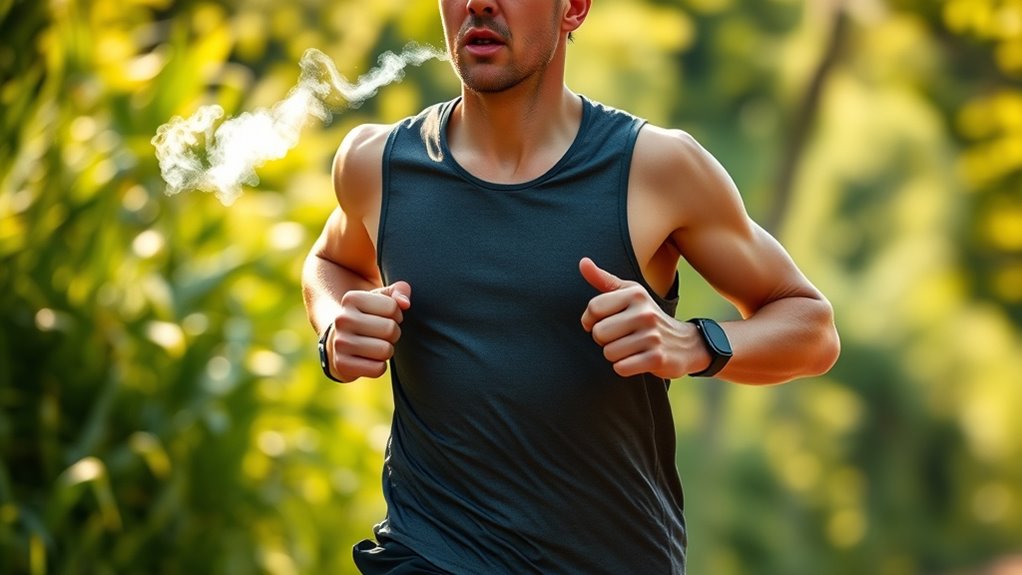To boost your VO₂ max mid-run, focus on controlled, deep breathing like diaphragmatic or belly breathing to maximize oxygen intake. Use rhythmic patterns aligned with your pace, such as 2:2 or 3:2, to enhance efficiency and oxygen delivery. Incorporate breath control techniques, like longer exhalations or breath holds, to increase lung capacity over time. mastering these strategies can help you sustain effort longer—keep exploring to *release* more breathing tips tailored for peak performance.
Key Takeaways
- Use diaphragmatic (belly) breathing to increase lung capacity and enhance oxygen intake during mid-run efforts.
- Incorporate rhythmic breathing patterns aligned with your pace (e.g., 2:2 or 3:2) to optimize oxygen exchange.
- Practice breath holds during lower-intensity segments to stimulate lung expansion and improve gas exchange efficiency.
- Adjust inhale and exhale depth based on effort level, maintaining steady, controlled breathing to support VO₂ max.
- Synchronize breathing with stride cadence to improve respiratory efficiency and delay fatigue during high-intensity runs.
Understanding the Role of Breathing in Running Performance

Breathing plays a essential role in running performance because it supplies your muscles with the oxygen they need to sustain effort and clear out carbon dioxide. Efficient breathing involves your respiratory muscles working effectively to maximize oxygen saturation in your blood. When you breathe well, these muscles help you take in more oxygen, ensuring your muscles receive enough to perform excellently. If your respiratory muscles aren’t strong, your oxygen saturation levels can drop, leading to fatigue and decreased endurance. Proper breathing techniques enhance the efficiency of your respiratory muscles, allowing you to maintain higher oxygen levels during intense runs. This balance between oxygen intake and carbon dioxide removal is fundamental for sustaining effort and improving overall running performance. Strengthening your respiratory muscles can further optimize oxygen exchange and improve VO₂ max. Improving breathing mechanics can also help you breathe more efficiently and support better athletic performance. Engaging in specific mindfulness breathing exercises can help you develop better control over your breathing patterns, further enhancing your athletic capacity. Understanding this connection helps you harness better breathing strategies to boost your VO₂ max, especially when combined with targeted training methods and performance-focused breathing exercises.
Diaphragmatic Breathing for Improved Oxygen Intake

Diaphragmatic breathing, also known as belly breathing, is a highly effective technique for enhancing your oxygen intake during runs. By focusing on proper breathing biomechanics, you activate your diaphragm fully, increasing lung capacity and efficiency. This method trains your respiratory muscles, making each breath more effective and reducing fatigue. When you practice diaphragmatic breathing, you learn to engage your core muscles, which supports deeper inhalations and better oxygen delivery to your muscles. Incorporating respiratory muscle training into your routine improves your overall breathing pattern, helping you sustain effort longer and recover faster. This technique not only boosts oxygen intake mid-run but also promotes better breathing habits over time, leading to enhanced overall running performance. Enhancing respiratory efficiency can further optimize your oxygen intake and endurance during exercise. Developing proper breathing techniques can also help prevent fatigue and improve stamina. Additionally, strengthening your respiratory muscles through targeted exercises can further improve your breathing effectiveness during strenuous activity, especially when you incorporate breathing exercises designed to increase lung capacity.
Rhythmic Breathing Patterns to Enhance Efficiency

By adopting rhythmic breathing patterns, you can substantially improve your running efficiency and conserve energy. Keeping a steady inhale and exhale aligned with your pacing strategies helps maintain a smooth rhythm, reducing fatigue. Consistent breathing also supports hydration optimization by preventing dehydration-induced cramping. Proper breathing techniques can also influence your overall oxygen uptake efficiency, contributing to better endurance. To illustrate, consider these common patterns:
| Pattern | Pace Suitability | Benefits |
|---|---|---|
| 2:2 | Moderate runs | Energy conservation |
| 3:2 | Faster runs | Improved oxygen delivery |
| 2:1 | Sprint intervals | Maximal effort efficiency |
| 4:4 | Recovery runs | Relaxation and hydration |
Matching your breathing pattern to your running pace enhances efficiency and helps you stay hydrated, ultimately boosting VO₂ max mid-run. Incorporating breathing techniques that promote self-awareness can further optimize your performance and endurance.
The Power of Inhalation and Exhalation Control

Controlling your inhalation and exhalation can markedly enhance your oxygen intake and overall running performance. By developing breath awareness, you become more conscious of your breathing patterns, allowing for better regulation of airflow. Proper inhalation timing ensures you maximize oxygen intake during each breath, reducing fatigue and improving endurance. Focus on these key techniques:
- Maintain smooth, deliberate inhalations that match your stride rhythm.
- Use controlled exhalations to fully empty your lungs, preventing shallow breathing.
- Synchronize your breath with your running cadence for efficiency and stability.
Mastering these aspects helps you optimize oxygen delivery, conserve energy, and run more efficiently. Consistent practice of inhalation and exhalation control is essential to boost VO₂ max during your mid-run efforts.
Incorporating Breath Holds for Increased Lung Capacity

Incorporating breath holds into your training can substantially boost your lung capacity and oxygen efficiency. Breath hold benefits include increasing the ability to store and utilize oxygen more effectively, which enhances endurance during runs. Lung capacity training with deliberate breath holds pushes your respiratory system to adapt, strengthening your lungs over time. By holding your breath for controlled intervals, you stimulate lung expansion and improve gas exchange, making each breath more efficient. This practice also helps you become more comfortable with elevated carbon dioxide levels, reducing the urge to breathe during intense effort. Regularly integrating breath holds into your routine can lead to noticeable improvements in VO₂ max, helping you run longer and faster with less fatigue.
Pursed-Lip Breathing to Manage Effort and Improve Gas Exchange

Pursed-lip breathing is a simple yet effective technique to help you manage effort during intense exercise and enhance gas exchange in your lungs. By exhaling slowly through pursed lips, you increase airway pressure, which prevents airway collapse and improves oxygen exchange. This method helps regulate effort, making challenging parts of your run feel more manageable.
Here’s how to use pursed-lip breathing for effort regulation:
- Inhale deeply through your nose, filling your lungs.
- Purse your lips as if blowing out a candle.
- Exhale slowly and steadily through pursed lips, controlling the effort.
This technique reduces shortness of breath and keeps your effort steady, ultimately supporting better lung function and VO₂ max during your run.
Using Breathing Techniques During Different Running Phases

Different phases of your run demand specific breathing strategies to optimize performance and maintain effort. During your warm-up or easy runs, focus on breath awareness and nasal breathing, which helps regulate oxygen intake and keeps you relaxed. As you increase intensity, such as during tempo or interval efforts, switch to deeper, controlled breathing to supply muscles with oxygen efficiently. During sprints or the final push, don’t hold back—use rapid, rhythmic breathing to sustain energy. Recognizing when to adapt your breathing technique ensures better oxygen exchange and reduces fatigue. Pay attention to your body’s signals, and adjust your breath pattern accordingly. Mastering these variations across different running phases helps you maintain a steady effort and supports your goal to boost VO₂ max.
Practical Tips for Integrating Breathing Exercises Into Your Runs

To effectively boost your VO₂ max, integrating targeted breathing exercises into your runs can make a significant difference. Focus on breath awareness to stay conscious of your inhalations and exhalations, helping you optimize oxygen intake. Incorporate lung strengthening techniques gradually to enhance capacity and endurance. Here are practical tips to get started:
- Practice diaphragmatic breathing during warm-ups to improve breath awareness.
- Incorporate intervals of controlled, deep breaths during your runs to strengthen lungs.
- Use rhythmic breathing patterns to maintain steady oxygen flow and reduce fatigue.
Frequently Asked Questions
How Long Should I Practice Breathing Exercises Before Seeing Improvements?
You might wonder how long it takes to see improvements from breathing exercises. With consistent timing and dedicated practice, you’ll likely notice progress within a few weeks. Focus on mastering the technique first, then maintain regular practice to optimize results. Keep in mind that patience and perseverance are key; the more consistent you are, the faster you’ll enhance your breathing efficiency and boost your VO₂ max over time.
Can Breathing Techniques Help Prevent Running-Related Injuries?
They say, “An ounce of prevention is worth a pound of cure,” and that’s true for running injuries. Breathing techniques alone won’t prevent injuries, but combined with good core strength and hydration strategies, they support better posture and muscle function. Focus on maintaining proper breathing, strengthen your core, and stay hydrated. These habits reduce strain and promote recovery, helping you stay injury-free and enjoy your runs even more.
Are Certain Breathing Methods Better for Beginners or Advanced Runners?
You might wonder if specific breathing methods suit beginners or advanced runners. Generally, simpler breathing patterns like deep diaphragmatic breaths work well for beginners during initial training phases, helping build endurance and comfort. As you advance, you can incorporate more complex breathing techniques to optimize oxygen intake during intense training phases. Adjust your breathing patterns based on your experience, gradually progressing to more sophisticated methods as your fitness and training demands increase.
How Do Environmental Factors Affect Breathing Techniques During Runs?
Environmental factors like air quality and altitude adaptation markedly influence your breathing techniques during runs. Poor air quality can cause you to breathe more shallowly or quickly, making it harder to maintain the right technique. At higher altitudes, your body needs time to adapt, so you might breathe more heavily initially. Adjust your breathing and pace accordingly to stay comfortable and optimize oxygen intake in different environments.
What Signs Indicate I Need to Adjust My Breathing During a Run?
When you notice signs of fatigue or irregular breathing patterns during a run, it’s time to adjust your breathing. You may feel short of breath, gasp for air, or notice your breathing becoming rapid or shallow. These signs indicate you should slow down, focus on deep, controlled breaths, and maintain a steady breathing pattern. Doing so helps improve oxygen intake, reduces fatigue, and keeps your run comfortable and efficient.
Conclusion
By mastering your breathing, you boost your VO₂ max, enhance your endurance, and elevate your running. Focus on diaphragmatic breathing, practice rhythmic patterns, control your inhalations and exhalations, and incorporate breath holds and pursed-lip techniques. Integrate these methods into your runs to improve efficiency, increase lung capacity, and manage effort. Breathe better, run farther, and push harder—because your breath is your greatest tool for running success.









